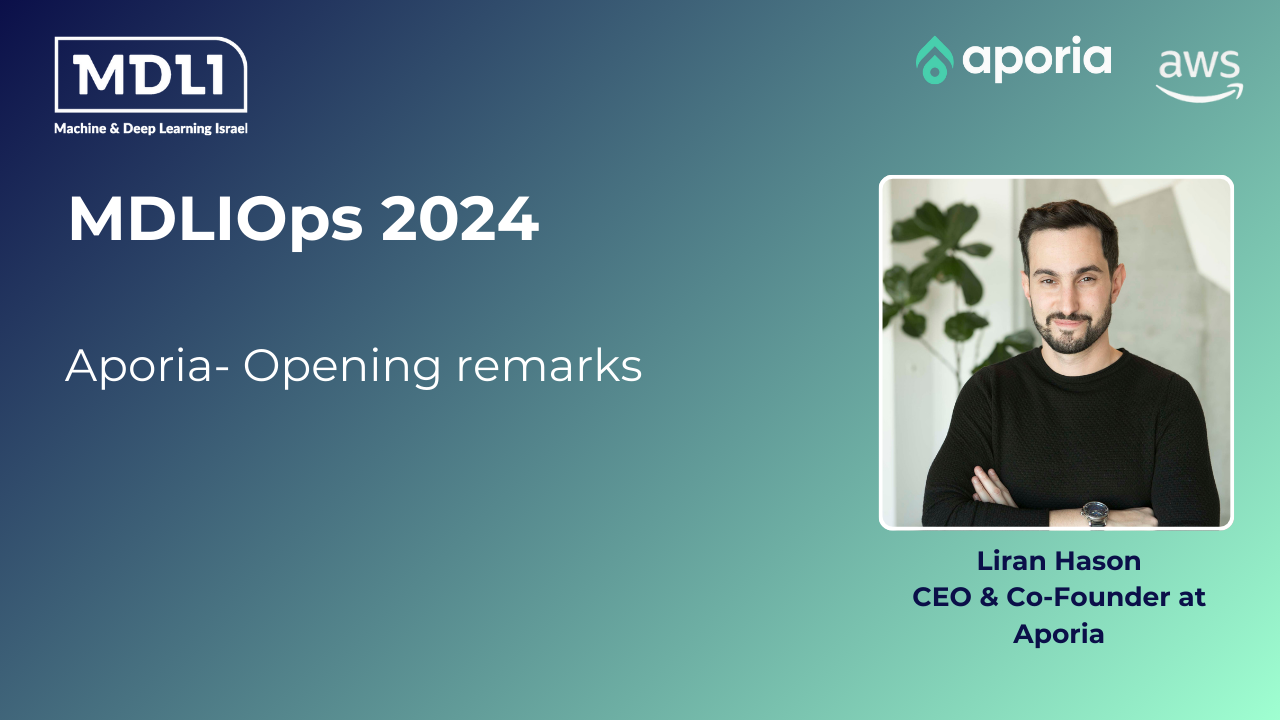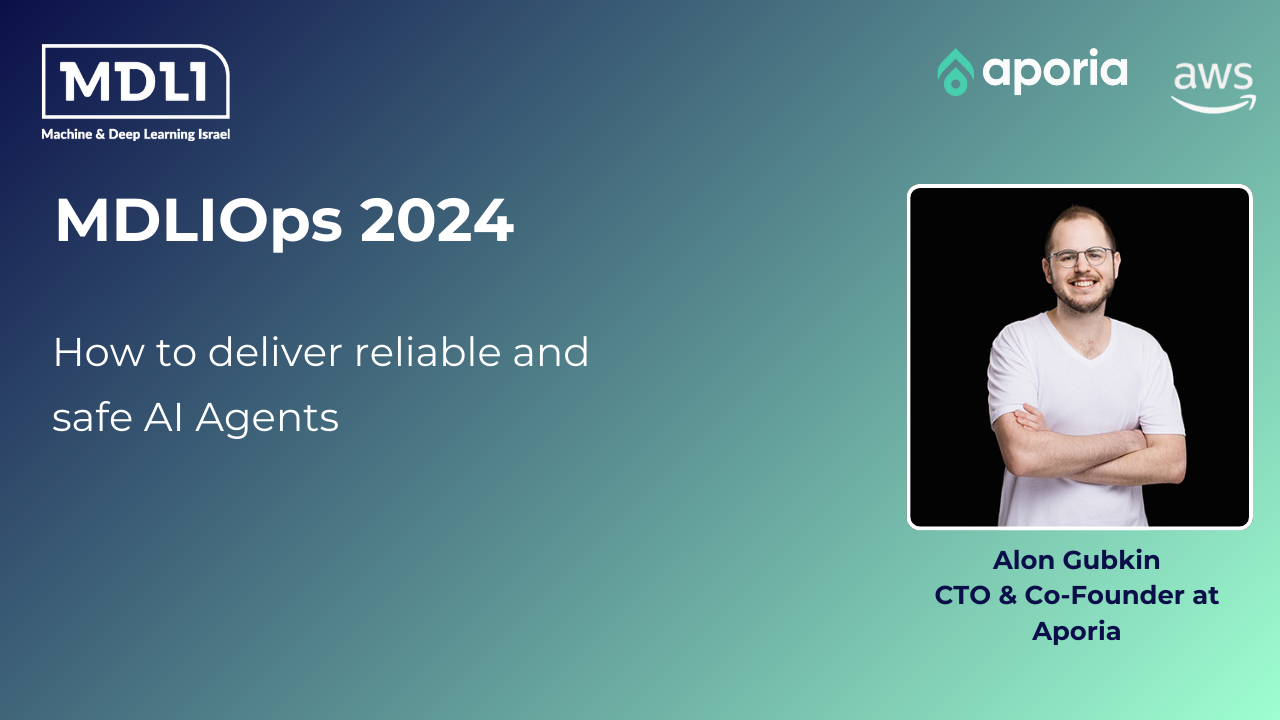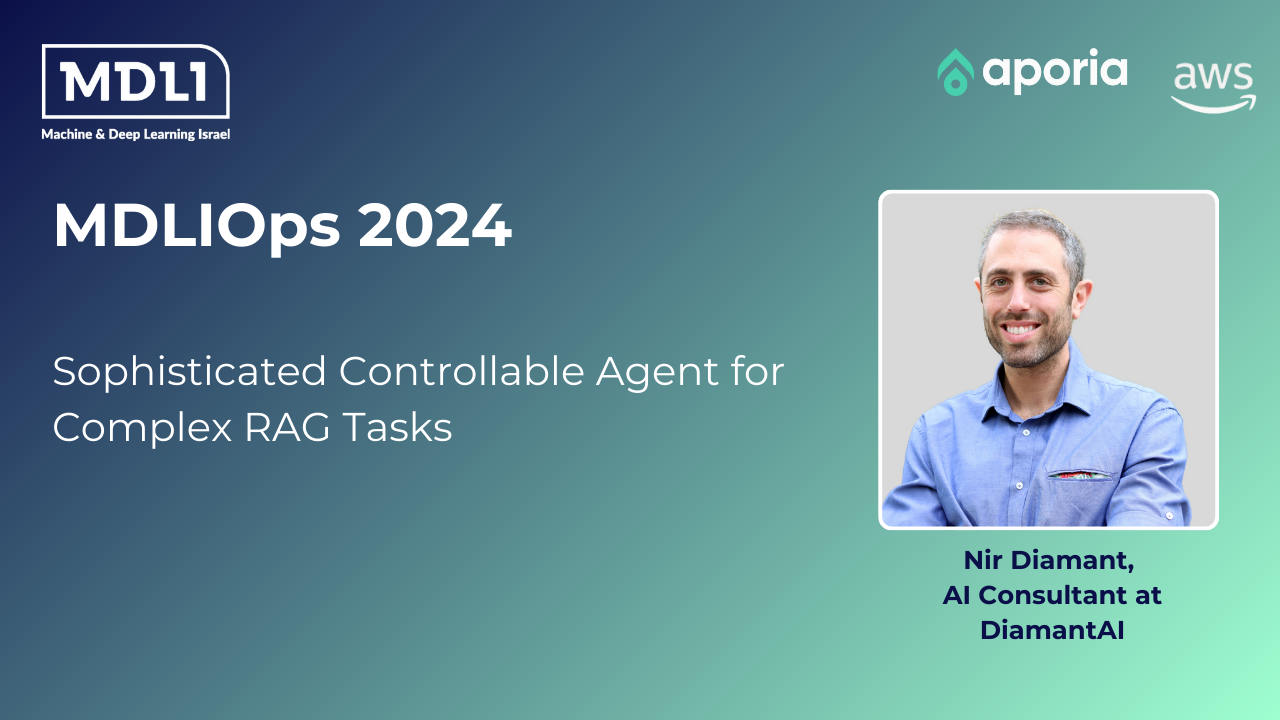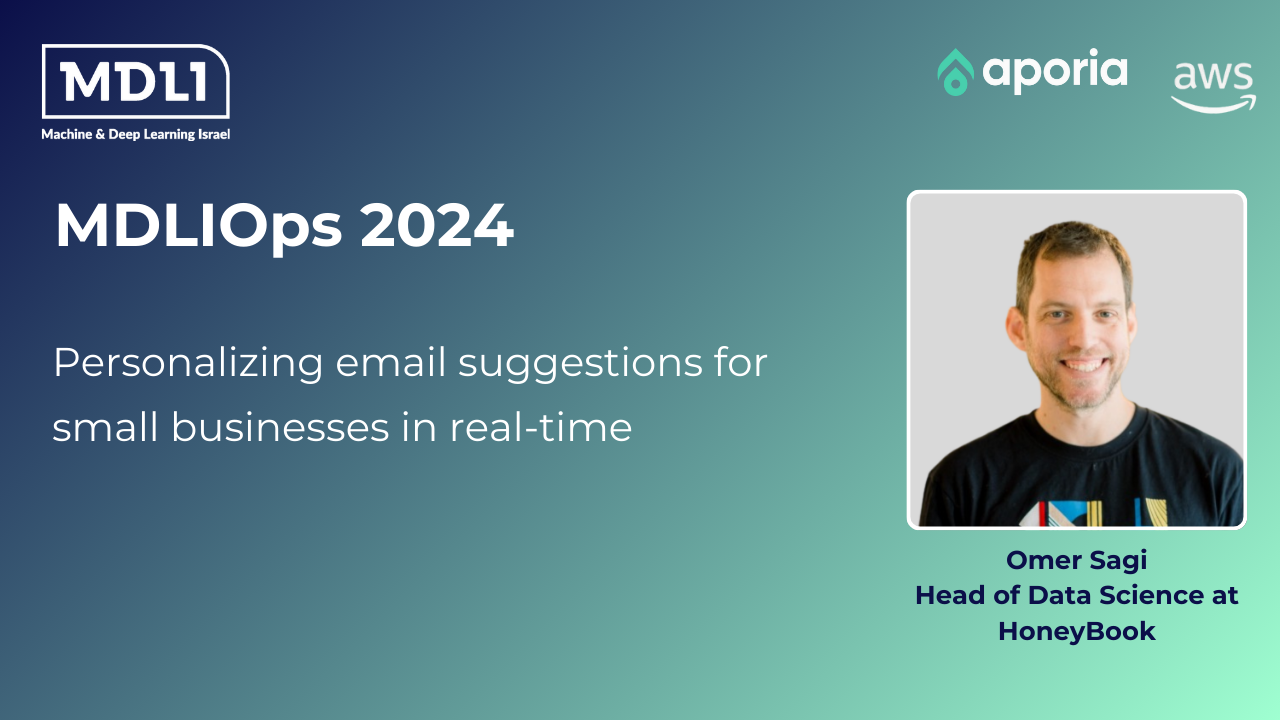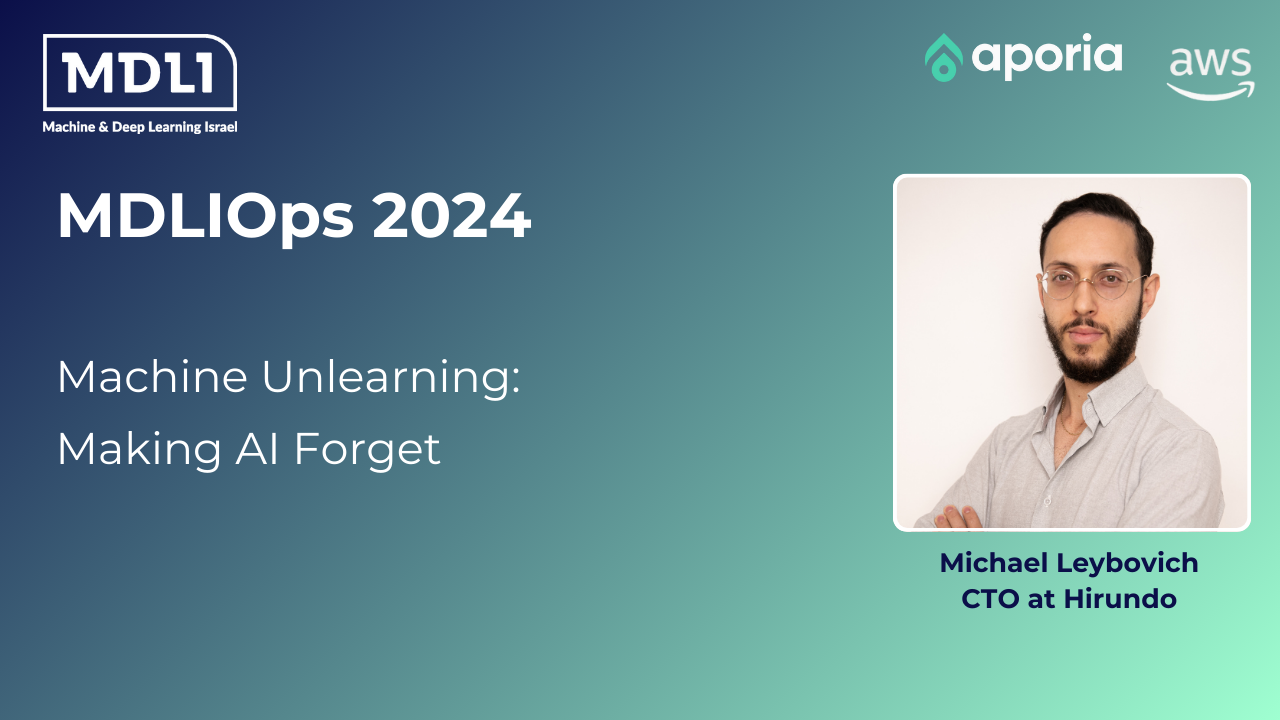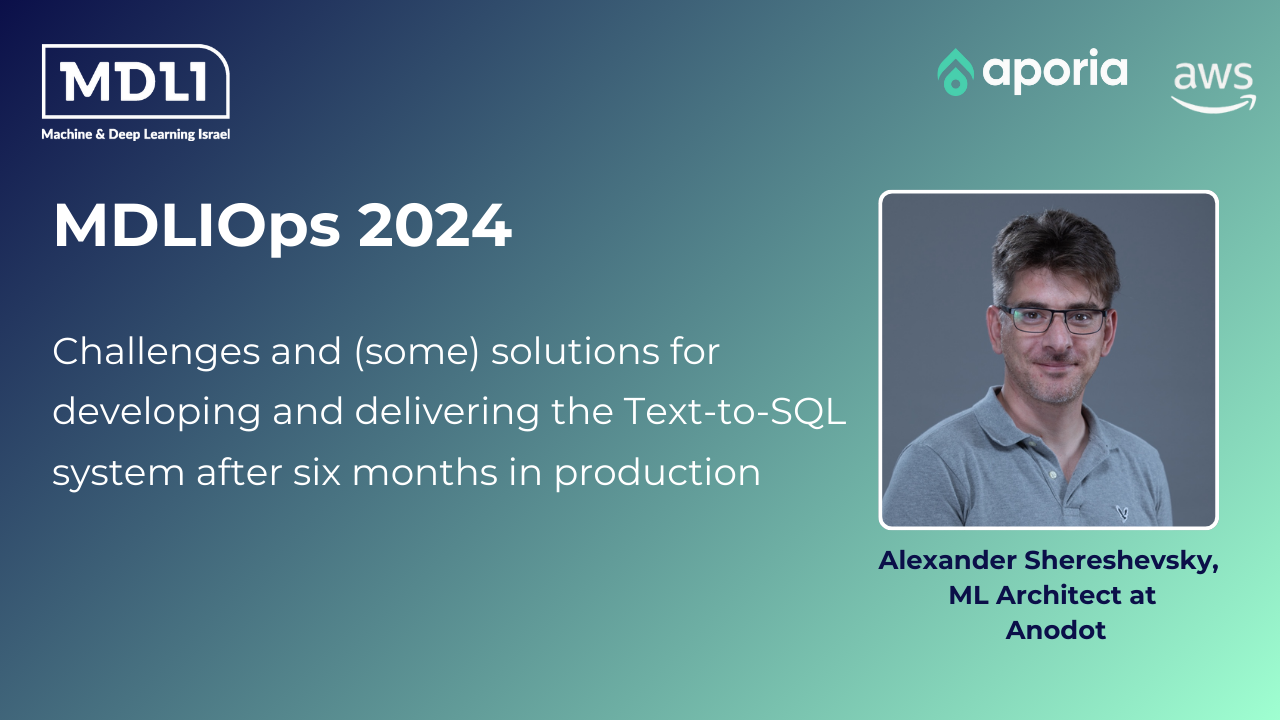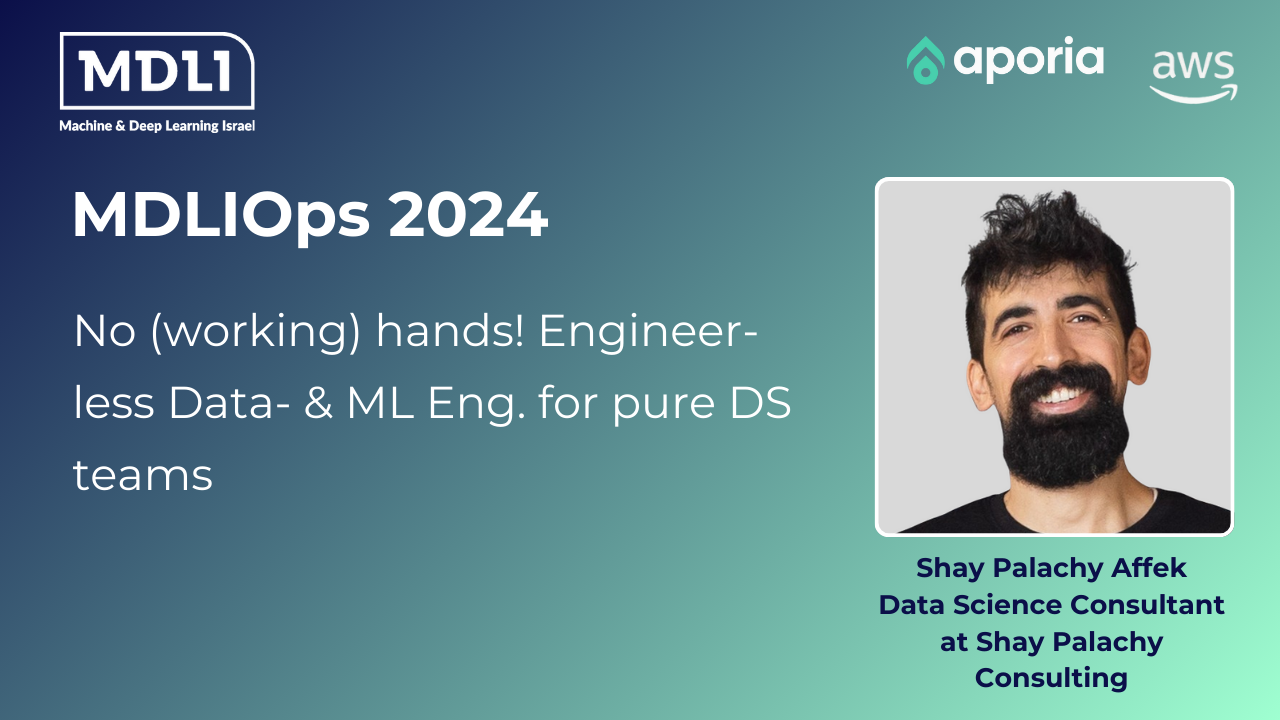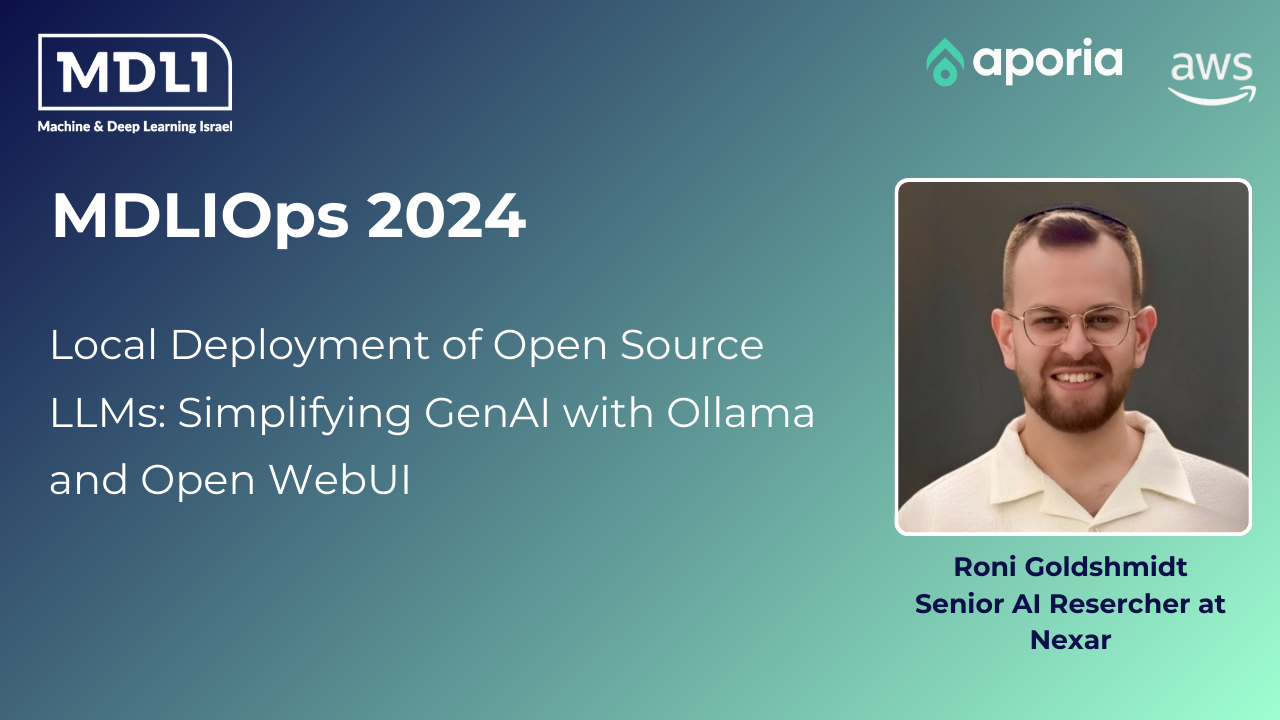MDLIOps 2024
Thank you for participating in our event!
Event closed
Scroll to see how amazing it was
11
2024 July
09:00-15:30
Tel Aviv
AWS FLOOR28
Menachem Begin 121


Thank you for participating!
MDLIops explores the technical aspects of generative AI. This event bringing together AI enthusiasts, researchers, and professionals for a day of thought-provoking discussions, presentations, and networking.
We want to thank the MDLIOPS 2024 conference partners, Aporia and AWS, for their valuable contribution to this event's success. Their support has enabled us to bring together leading experts and researchers in MLOPS. We would also like to thank our speakers for sharing their knowledge and insight with us.
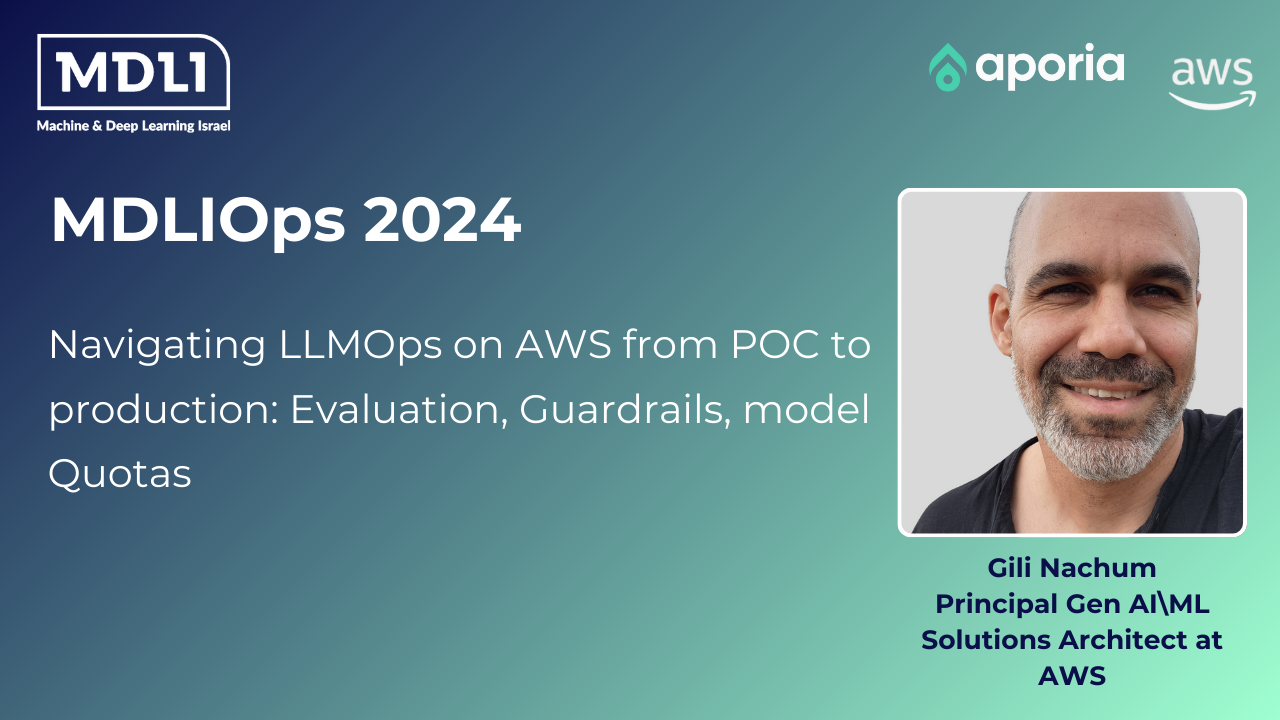
Navigating LLMOps on AWS from POC to production: Evaluation, Guardrails, model Quotas - Gili Nachum
20 min
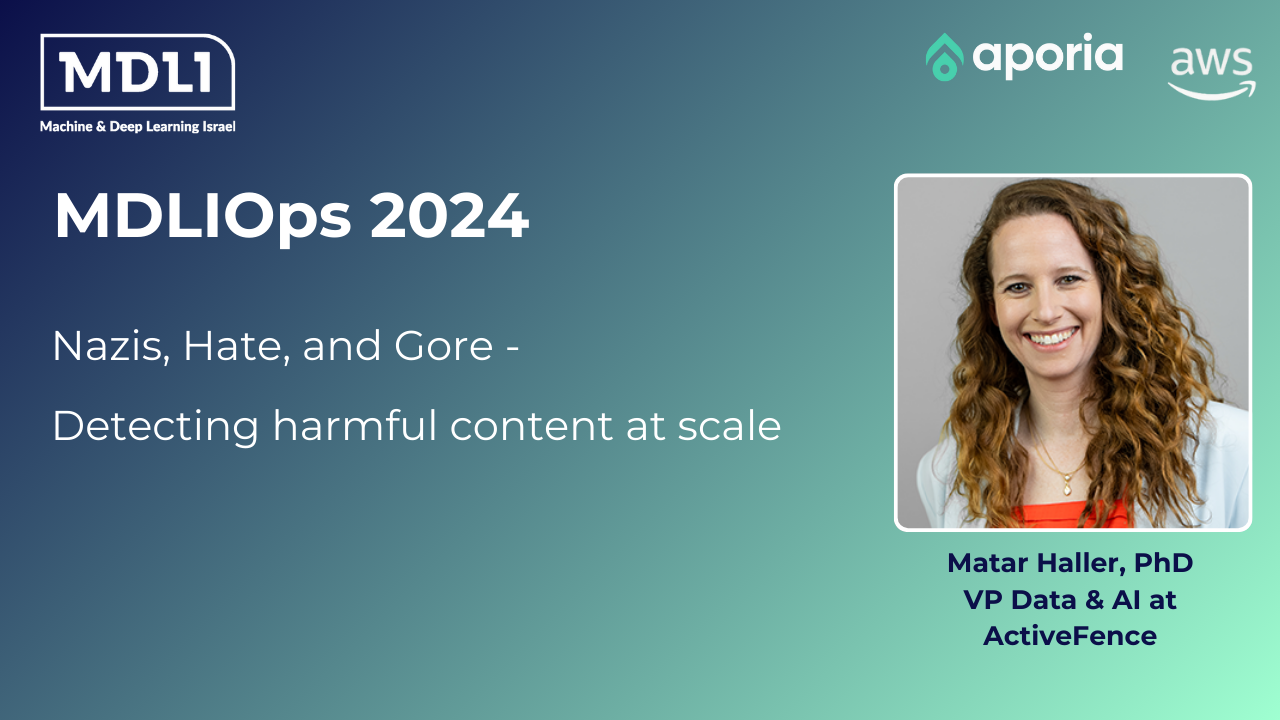
Nazis, Hate, and Gore - Detecting harmful content at scale - Matar Haller, VP Data & AI ActiveFence
20 min

How to leverage Document AI to simplify people’s financial lives in the GenAI era, Shir Meir, Intuit
20 min
How to deliver reliable and safe AI Agents - Alon Gubkinת, CTO & Co-Founder Aporia
Navigating LLMOps on AWS from POC to production: Evaluation, Guardrails, model Quotas - Gili Nachum
Sophisticated Controllable Agent for Complex RAG Tasks - Nir Diamant, AI Consultant.
Personalizing email suggestions for small businesses in real-time - Omer Sagi, HoneyBook
How to leverage Document AI to simplify people’s financial lives in the GenAI era, Shir Meir, Intuit
Machine Unlearning: Making AI Forget- Michael Leybovich, Hirundo
Challenges & solutions for developing the Text-2-SQL system. Alexander Shereshevsky, Anodot
No (working) hands! Engineer-less Data- & ML Eng. for pure DS teams- Shay Palachy Affek,Consulting
Simplifying GenAI with Ollama and Open WebUI- Roni Goldshmidt, Nexar
Challenges and lessons learned from training diffusion models from scrat5ch- Bar Fingerman, BRIA

Stay tuned for upcoming events
Speakers
Agenda
09:00-09:30
Coffee, Treats, and Chats: Mingling at the MDLiops Get-Together
09:30-09:40
Welcome to MDLIops 2024

Uri Eliabayev
Founder at MDLI
09:40-09:50
Keynote

Liran Hason
CEO & Co-Founder at Aporia
09:50-10:10
How to deliver reliable and safe AI Agents

Alon Gubkin
CTO & Co-Founder at Aporia
10:15-10:35
Navigating LLMOps on AWS from POC to production: Evaluation, Guardrails, model Quotas.

Gili Nachum
Principal Gen AI & ML Solutions Architect at AWS
10:40-11:00
Nazis, Hate, and Gore - Detecting harmful content at scale
One of the biggest challenges facing online platforms today is detecting harmful content and malicious behavior, including bullying, self-harm, hate speech, and violence. With the vast amount of online content, the only surefire way to keep users safe is by leveraging AI. In this talk, I will discuss how ActiveFence approached this challenge by scaling our operation to provide maximum protection for online users. I will share our journey, starting from a few models used asynchronously by in-house intelligence analysts, to building a synchronous API that serves dozens of models in near real-time for our SaaS clients. I will also share some of the mistakes and pitfalls we encountered, as well as how we achieved all this without breaking the bank.

Matar Haller, PhD
VP Data & AI at ActiveFence
11:05-11:25
Sophisticated Controllable Agent for Complex RAG Tasks
The lecture discusses a sophisticated solution for solving tasks that require access to your data as well as reasoning capabilities. This closed solution enables full control and understanding of the process, giving the user maximum ability to monitor and avoid hallucinations. It also allows for maximum reliance on the provided data rather than the pre-trained knowledge of the language model.

Nir Diamant
AI Consultant at DiamantAI
11:25-11:40
Break
11:45-12:05
Personalizing email suggestions for small businesses in real-time
Getting real-time personalized responses to client inquiries is a game-changer for small businesses. In this session, we’ll share how we mixed Kafka, Amazon Feature Store, and OpenAI's GPT-4 to make this happen. We used Kafka to manage a flood of client messages, Amazon Feature Store to keep track of each business's unique way of talking, and GPT-4 to craft personalized replies on the fly. We'll walk through how the messages flow from Kafka to a Python service, get spruced up with business-specific styles from the Feature Store, and then meet GPT-4 for a final touch of personalization.

Omer Sagi
Head of Data Science at HoneyBook
12:10-12:30
How to leverage Document AI to simplify people’s financial lives in the GenAI era
Documents are a principal part of our day to day finance management. Accessing and extracting the data embedded in documents has become one of the most highly sought-after technologies in many sectors, including financial services, real estate, insurance, government, legal, and healthcare. A central goal shared among these sectors is automating document processing to extract the documents’ fundamental structured information and instantly deliver that information when needed. Documents for which this goal is relevant include financial documents (e.g., receipts, invoices, contracts, mortgage documents, loan applications, purchase orders), government documents (e.g., tax forms, licenses certificates), among many more.
Manual extraction of information from documents can take 3-5 minutes depending on the amount of key information and the complexity of the document. Without automation, the time-consuming manual work for document-intensive tasks – medical case review, evidence processing, tax preparation, small business accounting, to name a few – can quickly add up to hours and hours that could be better spent. The primary challenge with information extraction from such documents is that the embedded data is stored in disparate formats. For example, a combination of unstructured text, semi-structured content (e.g., multi-column formats, tables, key-value pairs), and graphical content (e.g., figures and vector graphics).
Intelligent understanding and interpretation of data within documents is a critical and challenging application of artificial intelligence (AI).
In this talk we will share the state-of-the-art of document understanding techniques and how they are evolving in the generative AI era.

Shir Meir Lador
Data science group manager at Intuit
12:35-12:55
Machine Unlearning: Making AI Forget
In this talk, we will explore the concept of machine unlearning, its various use cases, and why it is essential in today's rapidly evolving technological landscape. Machine unlearning refers to the process of removing specific data or learned information from machine learning models to ensure privacy, compliance, and improved performance. We will discuss different approaches to machine unlearning, supported by relevant research papers, and address the challenges associated with this process.

Michael Leybovich
CTO at Hirundo
13:00-13:20
Challenges and (some) solutions for developing and delivering the Text-to-SQL system after six months in production.
We will discuss specific strategies for building context, managing query results, and integrating feedback to enhance system performance. The focus will be on the methods used to improve the system’s natural language processing capabilities and the technical decisions crucial for maintaining precision in SQL query results.

Alexander Shereshevsky
ML Architect at Anodot
13:20-14:00
Lunch Break
14:10-14:30
No (working) hands! Engineer-less Data- & ML Eng. for pure DS teams
In this talk I'll share the story of guiding a small, junior, engineer-less analytics & DS team in a successful transformation of an old, slow and complex data warehouse system into a fully fledged scale-capable, multi-tenant, pure Python, modern Data Lakehouse on Databricks, with extremely minimal support from R&D, for all existing and new BI analytics and models in the company.

Shay Palachy Affek
Data Science Consultant at Shy Palachy Consulting
14:35-14:55
Local Deployment of Open Source LLMs: Simplifying GenAI with Ollama and Open WebUI
This lecture offers a practical guide to deploying and managing open-source Large Language Models (LLMs) locally using Ollama, a platform that supports the streamlined use of pre-quantized models on both GPU and CPU setups. Attendees will learn how Ollama enables efficient AI model deployment on personal hardware, providing significant performance even on standard CPUs. The session will also highlight Open WebUI, a user-friendly interface that improves model interactions, offering a privacy-focused and customizable user experience similar to ChatGPT. By the end of this presentation, participants will gain the necessary knowledge to set up their own secure, private AI environment, ready to handle everything from simple queries to advanced, multimodal interactions. This lecture is ideal for developers, researchers, and tech enthusiasts aiming to leverage the capabilities of LLMs within their own secure setups and implement the logic of "LLM in the loop" within the organization.

Roni Goldshmidt
Senior AI Resercher at Nexar
15:00-15:20
Challenges and lessons learned from training diffusion models from scrat5ch
At Bria, we train models from scratch using a supercomputer built on the cloud. I will share the challenges, best practices, lessons learned, and provide a deep overview behind the scenes of how these models work and the infrastructure that supports them. By the end of this session, you should have a deep understanding of the project's complexity and the necessary technology, as well as knowledge that can help you get started with your own training. *Short slide about the math behind these models

Bar Fingerman
AI Eng Manager at Qodo
